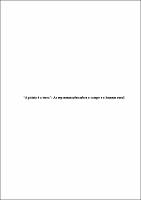Por favor, use este identificador para citar o enlazar este ítem:
http://rima110.im.ufrrj.br:8080/jspui/handle/20.500.14407/12706Registro completo de metadatos
| Campo DC | Valor | Lengua/Idioma |
|---|---|---|
| dc.creator | Beskow, Gabriela Carames | pt_BR |
| dc.date.accessioned | 2023-11-19T23:11:29Z | - |
| dc.date.available | 2023-11-19T23:11:29Z | - |
| dc.date.issued | 2010-02-03 | |
| dc.identifier.citation | BESKOW, Gabriela Carames. "A pátria é a terra": as representações sobre o campo e o homem rural construídas pelo Estado Novo. 2010. 169 f. Tese (Doutorado em Ciências Sociais em Desenvolvimento, Agricultura e Sociedade) - Instituto de Ciências Humanas e Sociais, Universidade Federal Rural do Rio de Janeiro, Seropédica, 2010. | por |
| dc.identifier.uri | https://rima.ufrrj.br/jspui/handle/20.500.14407/12706 | - |
| dc.description.abstract | The present work intends to analyze the representations that were built about the rural space and the rural man by the New State. We believe that these representations were part of the ideological elaboration that had as objective to legitimate the authoritarian regime, providing sustentation to the proposals of social, politics and economical transformations promoted by the State and contributing to forge a new brazilian national identity to propose social harmony, new forms of thinking the citizenship and the incorporation of sections previously marginalized especially the working class. The construction of the representations was linked with the economical aspect - the place occupied by the man and the rural space in the projects of economical development proposed by the State - as good as to the construction of a national identity in witch the field is associated to the roots of the nationality and of the Brazilian cultural traditions, and the rural man as ―typical‖ representative of these elements. The sources used in this work are speeches, photographs, paintings, school books and magazines witch were produced or appropriated by the New State regime to express the ideals of man and the rural space that seek to consolidate the brazilian national imaginary. | eng |
| dc.description.sponsorship | Conselho Nacional de Desenvolvimento Científico e Tecnológico - CNPq | pt_BR |
| dc.format | application/pdf | por |
| dc.language | por | por |
| dc.publisher | Universidade Federal Rural do Rio de Janeiro | por |
| dc.rights | Acesso Aberto | por |
| dc.subject | representações | por |
| dc.subject | campo | por |
| dc.subject | homem rural | por |
| dc.subject | estado novo | por |
| dc.subject | representations | eng |
| dc.subject | field | eng |
| dc.subject | rural man | eng |
| dc.subject | estado novo | eng |
| dc.title | "A pátria é a terra": as representações sobre o campo e o homem rural construídas pelo Estado Novo | por |
| dc.title.alternative | "The country is the land": the representations about the rural space and the rural man built by the Estado Novo | eng |
| dc.type | Tese | por |
| dc.contributor.advisor1 | Ferreras, Maria Verónica Secreto de | pt_BR |
| dc.contributor.advisor1ID | 048.127.257-71 | por |
| dc.contributor.advisor1Lattes | http://lattes.cnpq.br/7356794706502412 | por |
| dc.creator.ID | 091.101.577-94 | por |
| dc.creator.Lattes | http://lattes.cnpq.br/7906325189455521 | por |
| dc.description.resumo | O presente trabalho tem como objetivo analisar as representações construídas sobre o campo e o homem rural pelo Estado Novo. Acreditamos que estas representações faziam parte da elaboração ideológica que tinha como objetivo legitimar o regime autoritário, dando sustentação às propostas de transformação social, política e econômica, promovidas pelo estado. Contribuíam, ainda, para forjar uma nova identidade nacional brasileira que propunha a harmonia social, novas formas de pensar a cidadania e a incorporação de setores anteriormente marginalizados em especial, a classe trabalhadora. A construção das representações estava ligada tanto ao aspecto econômico, que diz respeito ao lugar ocupado pelo homem e pelo espaço rurais nos projetos de desenvolvimento econômico propostos pelo estado, quanto à questão da construção de uma identidade nacional na qual o campo é associado às raízes da nacionalidade e das tradições culturais brasileiras, e o homem rural é apresentado como representante ―típico‖ destes elementos. As fontes utilizadas neste trabalho são discursos, fotografias, pinturas, livros escolares e revistas, que eram produzidos ou apropriados pelo regime estadonovista para expressar os modelos ideais de homem e espaço rural que buscava consolidar no imaginário nacional brasileiro. | por |
| dc.publisher.country | Brasil | por |
| dc.publisher.department | Instituto de Ciências Humanas e Sociais | por |
| dc.publisher.initials | UFRRJ | por |
| dc.publisher.program | Programa de Pós-Graduação em Ciências Sociais em Desenvolvimento, Agricultura e Sociedade | por |
| dc.subject.cnpq | História | por |
| dc.thumbnail.url | https://tede.ufrrj.br/retrieve/31496/2010%20-%20Gabriela%20Carames%20Beskow.pdf.jpg | * |
| dc.thumbnail.url | https://tede.ufrrj.br/retrieve/37889/2010%20-%20Gabriela%20Carames%20Beskow.pdf.jpg | * |
| dc.thumbnail.url | https://tede.ufrrj.br/retrieve/44269/2010%20-%20Gabriela%20Carames%20Beskow.pdf.jpg | * |
| dc.thumbnail.url | https://tede.ufrrj.br/retrieve/50654/2010%20-%20Gabriela%20Carames%20Beskow.pdf.jpg | * |
| dc.thumbnail.url | https://tede.ufrrj.br/retrieve/57080/2010%20-%20Gabriela%20Carames%20Beskow.pdf.jpg | * |
| dc.originais.uri | https://tede.ufrrj.br/jspui/handle/tede/674 | |
| dc.originais.provenance | Made available in DSpace on 2016-04-28T20:13:41Z (GMT). No. of bitstreams: 1 2010 - Gabriela Carames Beskow.pdf: 4396200 bytes, checksum: fbb34d321cfaccdeb7bbf47325e1597f (MD5) Previous issue date: 2010-02-03 | eng |
| Aparece en las colecciones: | Doutorado em Ciências Sociais em Desenvolvimento, Agricultura e Sociedade | |
Se for cadastrado no RIMA, poderá receber informações por email.
Se ainda não tem uma conta, cadastre-se aqui!
Ficheros en este ítem:
| Fichero | Descripción | Tamaño | Formato | |
|---|---|---|---|---|
| 2010 - Gabriela Carames Beskow.pdf | 4.29 MB | Adobe PDF |  Visualizar/Abrir |
Los ítems de DSpace están protegidos por copyright, con todos los derechos reservados, a menos que se indique lo contrario.

